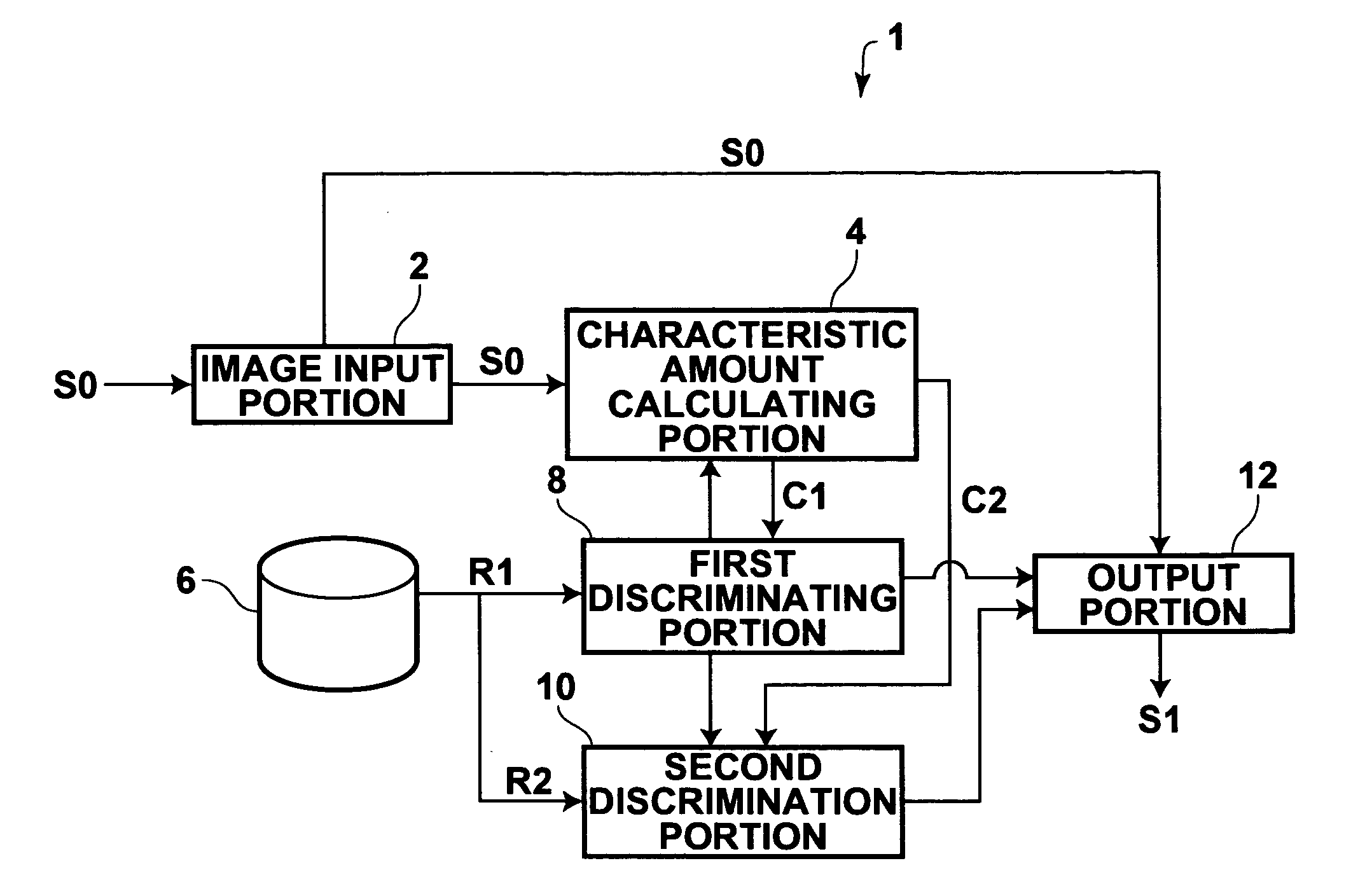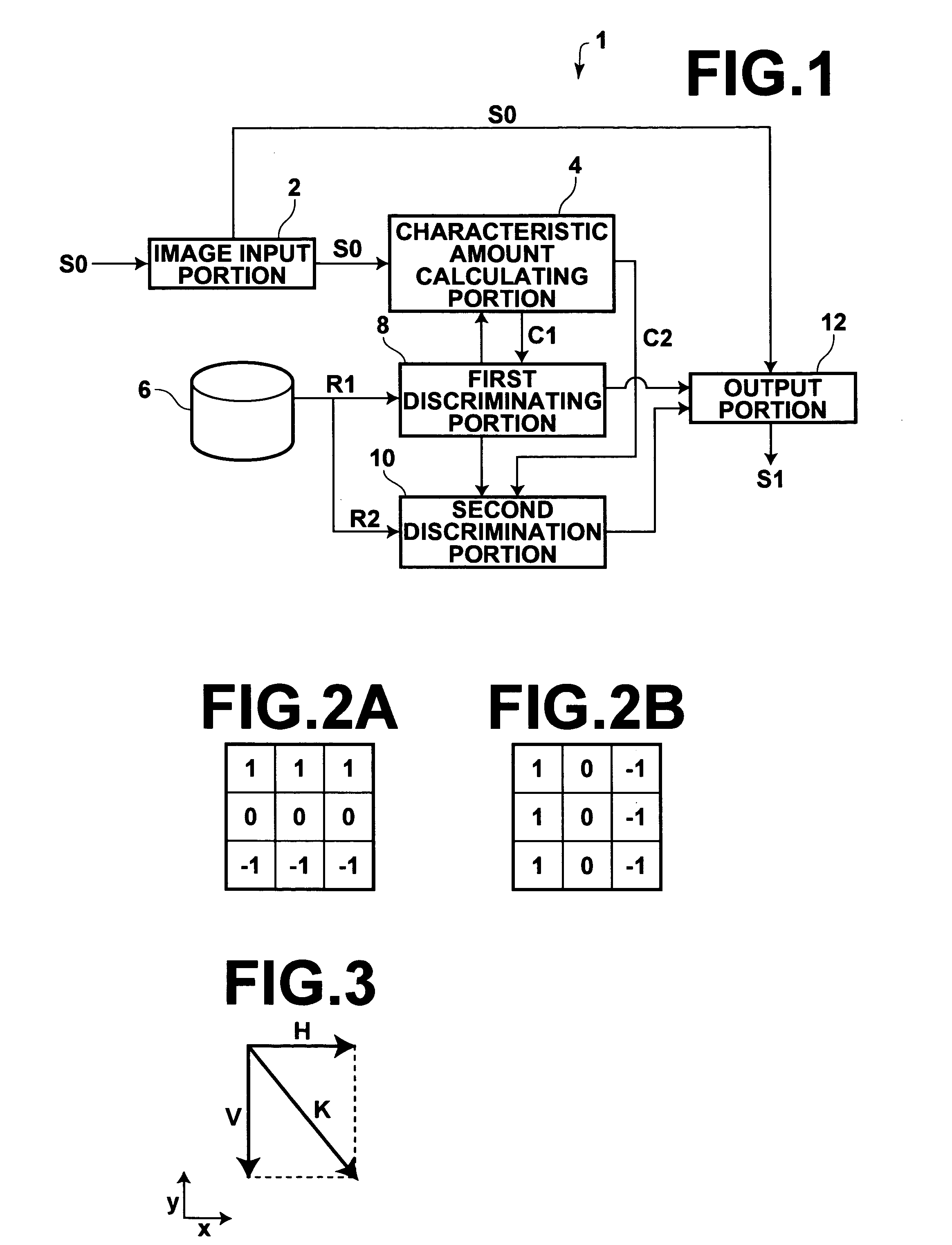Apparatus, method, and program for discriminating subjects
a subject discrimination and subject technology, applied in the field of subject discrimination apparatuses, can solve the problems of long processing time, complex shapes of subjects, such as human faces, that cannot be detected by this method, and cannot be discriminated by this method, so as to improve the discrimination ability of predetermined subjects, the effect of reducing the calculation time and reducing the processing tim
- Summary
- Abstract
- Description
- Claims
- Application Information
AI Technical Summary
Benefits of technology
Problems solved by technology
Method used
Image
Examples
first embodiment
[0199] In this manner, the first discriminating portion 8 of the subject discriminating apparatus 1 employs the directions of the gradient vectors K as the first characteristic amounts C1, which do not require normalization. Therefore, the amount of calculations is not excessive even if discrimination regarding whether a candidate is included is performed on the entire target image S0. As a result, discrimination regarding whether a candidate is included in the target image S0 can be performed at a comparatively high speed. Meanwhile, the second discriminating portion 10 normalizes the directions and magnitudes of the gradient vectors K, as the second characteristic amounts C2. Therefore, discrimination can be performed with high accuracy, although the amount of calculations increases. However, in the present embodiment, the second characteristic amounts are normalized and the second discrimination is performed only on the candidate portions, which are extracted from the target ima...
second embodiment
[0204]FIG. 15 is a flow chart that illustrates the processes performed by the control portion 14 of the When processes for discriminating whether a face is included in the target image S0 are initiated, the control portion 14 begins its process, by counting the number of times N1 that a candidate is discriminated within the target image S0 by the first discriminating portion 8 (step S31). Meanwhile, the number of times N2 that the second discriminating portion 10 discriminates that the candidate is a face is also counted (step S32).
[0205] Next, the control portion 14 judges whether the number of discriminated target images S0 (that is, the number of discriminations performed) has reached the predetermined number (step S33). If the judgment at step S33 is negative, the process returns to step S31, and the processes performed at steps S31 through S33 are repeated until the judgment at step S33 is affirmative. When the judgment at step S33 is affirmative, judgment is made regarding wh...
fourth embodiment
[0217] Note that the “positions of eyes” in the fourth embodiment refers to the center positions between the corners of the eyes. In the case that the eyes face front, as illustrated in FIG. 18A, the centers are the irises (denoted by X's in FIG. 18A). In the case that the eyes are looking toward the right, as illustrated in FIG. 18B, the centers are not the irises, but the whites of the eyes.
[0218] The characteristic amount calculating portion 104 calculates the characteristic amounts C0, to be employed in the discrimination of faces, from the target image S0. In the case that it is discriminated that a face is included in the target image S0, the characteristic amount calculating portion 104 calculates the characteristic amounts C0 from an image of the face (hereinafter, simply referred to as “facial image”), which is extracted as will be described later. Specifically, gradient vectors (the directions and magnitudes of density change at each pixel of the target image S0 and the fa...
PUM
 Login to View More
Login to View More Abstract
Description
Claims
Application Information
 Login to View More
Login to View More - R&D
- Intellectual Property
- Life Sciences
- Materials
- Tech Scout
- Unparalleled Data Quality
- Higher Quality Content
- 60% Fewer Hallucinations
Browse by: Latest US Patents, China's latest patents, Technical Efficacy Thesaurus, Application Domain, Technology Topic, Popular Technical Reports.
© 2025 PatSnap. All rights reserved.Legal|Privacy policy|Modern Slavery Act Transparency Statement|Sitemap|About US| Contact US: help@patsnap.com



